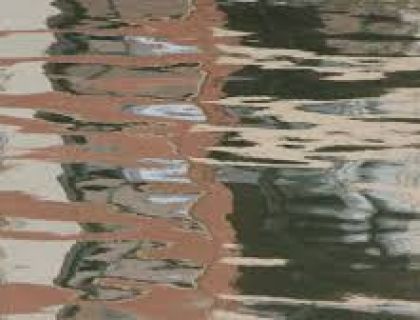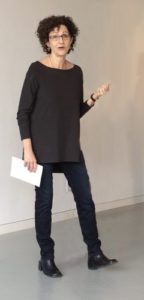Ellen Kozak: the river that flows both ways

.
Ellen Kozak, an artist and friend wedded (in addition to her spouse) to an animated being that lives and moves right by in front of her house in New Baltimore, New York: Muh-he-kun-ne-tuk, the river that flows both ways, the native American name for the Hudson river. Seldom have I met someone – outside of science — with her intensity and passionate immersion in one subject area. The meticulously done paintings portray the Hudson in its infinitely varying colors, shades, surface wrinkles, and reflections. In the interview I’m about to mention I found the term alla prima for the first time:
WIKI: alla prima is an Italian term meaning “at first attempt.” It indicates a method of oil painting in which a picture is completed by painting on the entire surface of the canvas all at once rather than by traditional method which required a methodical building of the image, piecemeal fashion with successive layers of paint. Today, alla prima painting is generally referred to as direct painting. In French it is called premier coup.
So her style, her mode of putting the paint onto canvass, is an act of bravura or masterly surety acquired over time as she found her vocation. I appreciate this capacity particularly since I approach decisions even on trivial matters, such as where to put a nail into the wall to hang a picture, with great timidity.
An in-depth interview of Ellen appeared on April 3, 2020 in an online magazine, Painting Perceptions. It was conducted by Larry Groff who is a painter himself, with the sensibility and thorough knowledge of the medium that is required to capture the subtleties of Ellen’s methods and ways of thinking.
Claire Lambe (who is cited in the interview from a review in Roll Magazine.com) wrote this about Ellen Kozak:
“Kozak’s oil paintings walk the line between representation and abstraction. Her particular interest is in the equivalences in the behavior of her subject and her materials, “I use paint as a mimetic medium, letting it physically perform like my subject. Oil paint and water share properties of viscosity: paint directed by a brush emulates a river’s surface stirred by wind or pulled by tide.” In the paintings, thinly painted on wood panels that have been prepared with a hand-made dry gesso, rifts of shimmering color evoke movement and, in some cases, the vibration of light on water, in others, the unfathomable depths. Over the years that Kozak has engaged in this work, the paintings have become less representational and more abstract, more reductive. Movements of color and form that, in earlier paintings, were descriptive of the water’s curves and arabesques have, in this recent work, been distilled into quite formal abstracts, many with a strong linear movement, but generally remaining faithful to the horizontal surface of the river.”
We can only hope that her paintings will soon be accessible again, in galleries, in social settings where appreciation is amplified by conversations among art lovers who share the same space at the same time — as in the world we remember.
.
.
